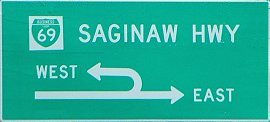The median U-turn, otherwise known as the Michigan left turn, has been a great asset in moving traffic safely and efficiently in Michigan for over 50 years. While widely used in Michigan, other states and countries have not adopted the Michigan left turn, in large part because the design is not included in standard manuals and software that highway designers use.

With the help of a $78,000 grant from the Science Applications International Corporation, a team led by Wayne State University’s Joseph Hummer, Ph.D., professor and chair of the Department of Civil and Environmental Engineering, will develop equations, text and software so that the Michigan left turn and three other alternative designs can be included in the next edition of the Highway Capacity Manual used by highway designers.
 According to Hummer, numerous research efforts and publications on alternative intersections and interchanges sponsored by the Federal Highway Administration (FHWA) have taken place in the last decade to enable analysis and deployment of alternative intersections and interchanges.
According to Hummer, numerous research efforts and publications on alternative intersections and interchanges sponsored by the Federal Highway Administration (FHWA) have taken place in the last decade to enable analysis and deployment of alternative intersections and interchanges.
“Unfortunately, most of the analysis of alternative intersections and interchanges to this point involved the use of microscopic simulations that are expensive and time consuming,” said Hummer. “The Highway Capacity Manual and the Highway Capacity Software — a widely used deterministic statistical equation-based analysis tool — have simpler and quicker procedures for conventional intersections and interchanges, but none for alternative designs.”
The alternatives have not been included to date due to the complex nature of traffic flow across multiple segments and junctions when compared to more conventional intersections and interchanges, according to Hummer.
In collaboration with researchers from North Carolina State University, University of Florida and Virginia Tech, Hummer will lead the group to develop credible procedures for four designs: the double crossover diamond interchange, the displaced left turn intersection, the restricted crossing U-turn intersection and the median U-turn or Michigan left turn intersection. These procedures will be included in the next version of the Highway Capacity Manual and the Highway Capacity Software.
“Our team has great expertise in alternative intersections and interchanges, Highway Capacity Manual procedures, development of computational engines, data collection techniques, intersection and interchange operational analysis techniques, statistical methods, simulation and calibration techniques, and developing concise and user-friendly guidance for a national audience of transportation and public safety practitioners,” said Hummer. “This experience will enable the team to efficiently develop, test, validate and facilitate adoption of these procedures so that transportation agencies can take a good look at alternative geometric designs for intersections and interchanges.”
Once the Highway Capacity Manual is updated with the Michigan left turn, the intersection design could be Michigan’s next big export.
“We hope that in the future when people think of products from Michigan, they think of autos, cherries — and Michigan left turns,” said Hummer.
Source: Wayne State University Division of Research
Was this article valuable?
Here are more articles you may enjoy.

 Asahi Sales Drop Worsens as Cyber Hack Disruption Lingers
Asahi Sales Drop Worsens as Cyber Hack Disruption Lingers  ‘Super Roofs’ Are Rewarding Insurers, Cat Bond Investors and Homeowners
‘Super Roofs’ Are Rewarding Insurers, Cat Bond Investors and Homeowners  ‘Dream Is in Sight:’ Chamber, Reinsurers, Insurers Urge Florida to Stay the Course
‘Dream Is in Sight:’ Chamber, Reinsurers, Insurers Urge Florida to Stay the Course  Atmospheric River to Flood Pacific Northwest Through Week
Atmospheric River to Flood Pacific Northwest Through Week 